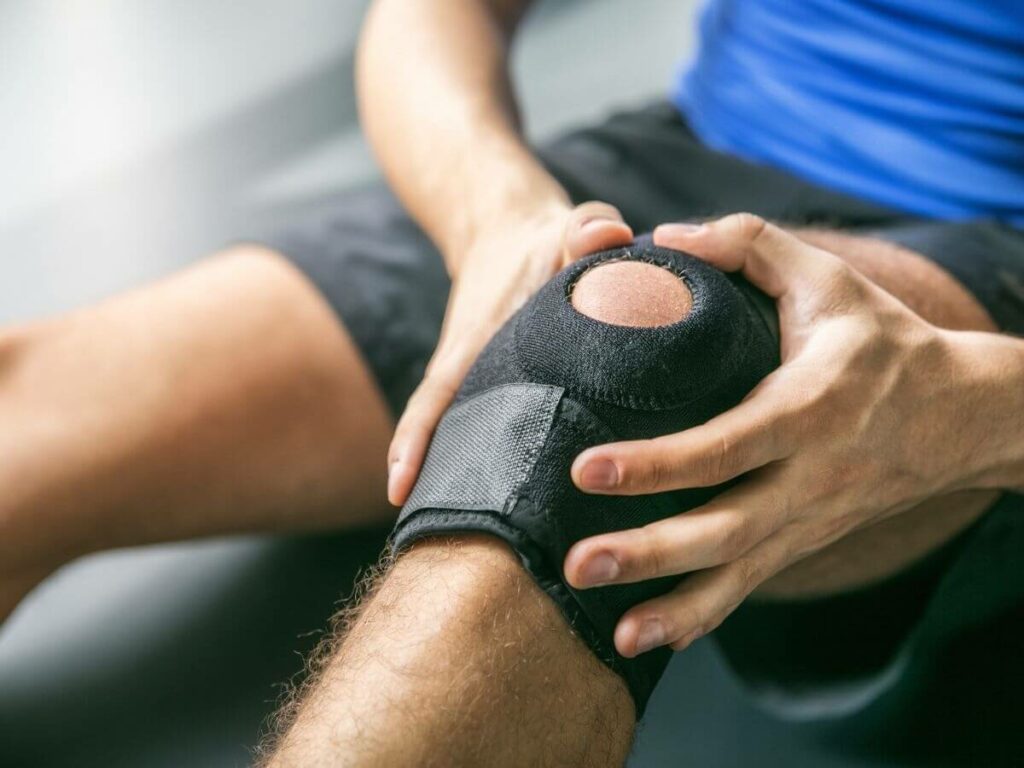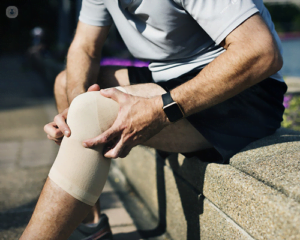Knee injuries are a common concern, often resulting from various activities, accidents, or overexertion. One type of knee injury that frequently occurs is hyperextended knee pain. In this article, we will delve into what hyperextended knee pain is, how it occurs, and the steps you can take for effective treatment and prevention.
Contents
Understanding Hyperextended Knee
To understand hyperextended knee pain, it’s important to have a grasp of knee joint anatomy. The knee joint is a complex structure comprising bones, ligaments, tendons, and cartilage.
Hyperextension of the knee occurs when the knee joint is bent backward beyond its normal range of motion. This can lead to strain on the ligaments and surrounding tissues.
Symptoms of Hyperextended Knee

A hyperextended knee occurs when the knee joint is forcefully bent beyond its normal range of motion in the backward direction. This can lead to stretching or tearing of ligaments, tendons, and other supporting structures around the knee. Common symptoms of a hyperextended knee include:
- Pain: Pain is usually felt at the back of the knee where the injury occurred. The pain can range from mild to severe, depending on the extent of the injury.
- Swelling: Swelling around the knee joint is a common response to injury. Swelling can cause the knee to feel stiff and limited in its range of motion.
- Bruising: Due to the trauma to blood vessels and tissues, bruising may develop around the knee area. The bruising can vary in color and severity.
- Stiffness: The knee might become stiff and difficult to fully bend or straighten. This can make walking, bending, and other activities uncomfortable or challenging.
- Instability: Hyperextension can lead to damage to the ligaments that help stabilize the knee joint. As a result, you might feel a sense of instability or weakness in the knee when trying to stand or move.
- Limited Range of Motion: The knee’s range of motion may be restricted, making it difficult to fully extend or flex the knee.
- Popping or Clicking Sensation: Some individuals might experience a popping or clicking sensation in the knee when moving it, which could indicate damage to the joint structures.
- Difficulty Weight Bearing: Walking or putting weight on the affected leg might be challenging due to pain and instability.
- Pain with Activities: Activities that involve bending, kneeling, or putting strain on the knee may exacerbate the pain and discomfort.
Diagnosing Hyperextended Knee Pain
Diagnosing hyperextended knee pain typically involves a combination of medical history, physical examination, and possibly imaging tests. Here’s how the process usually works:
Medical History: Your healthcare provider will begin by asking you questions about the circumstances surrounding the injury. They will inquire about when and how the injury occurred, the symptoms you’re experiencing, and any pre-existing conditions that might be relevant.
Physical Examination: A thorough physical examination is crucial to assess the extent of the injury. Your healthcare provider will examine your knee for signs of swelling, bruising, instability, and range of motion limitations. They might also perform various maneuvers to assess the integrity of the ligaments, tendons, and other structures in the knee.
Imaging Tests: In some cases, imaging tests might be ordered to get a more detailed view of the knee’s internal structures. Common imaging methods include:
- X-rays: X-rays can help rule out fractures and assess the alignment of the bones in the knee joint.
- MRI (Magnetic Resonance Imaging): An MRI provides detailed images of soft tissues like ligaments, tendons, and cartilage. This can help determine if there’s any tearing or damage to these structures.
Special Tests: If specific ligaments are suspected to be injured, your healthcare provider might perform special tests such as the Lachman test or the anterior drawer test to evaluate the stability of the knee joint.
Assessment of Range of Motion and Stability: Your healthcare provider will assess the range of motion of your knee joint and its stability. This might involve comparing the affected knee’s range of motion and stability with the unaffected knee.
Pain Assessment: You’ll be asked to describe the nature and location of the pain, which can help your healthcare provider narrow down the possible sources of the discomfort.
Hyperextended Knee Treatment Options

Treatment for a hyperextended knee will depend on the severity of the injury, the structures involved, and the individual’s overall health. Here are some common treatment options that healthcare professionals might consider:
Bracing and Support
Bracing and support are important components of the treatment for a hyperextended knee. These measures aim to provide stability, protection, and aid in the healing process. Here are some types of braces and supports that might be used for a hyperextended knee:
Knee Immobilizer:
- A knee immobilizer is a type of brace that limits the movement of the knee joint. It is often used in the early stages of treatment to prevent further stress on the injured structures.
- This brace is typically made of rigid material and keeps the knee in a fixed position, helping to reduce pain and promote healing.
Hinged Knee Brace:
- A hinged knee brace provides more support than an immobilizer and allows controlled movement of the knee.
- It has hinges that can be adjusted to limit the range of motion, providing stability while still allowing some degree of movement as prescribed by a healthcare professional.
- Hinged braces are often used during the recovery process when the knee needs protection while gradually regaining its function.
Surgical Intervention
Here are some surgical options that might be considered for a hyperextended knee:
Ligament Reconstruction:
- If the anterior cruciate ligament (ACL) or other major knee ligaments are torn due to hyperextension, ligament reconstruction surgery may be necessary.
- During this procedure, a surgeon replaces the damaged ligament with a graft, often taken from another part of the body (autograft) or a donor (allograft).
- Ligament reconstruction aims to restore stability to the knee and improve its overall function.
Repair of Torn Ligaments or Meniscus:
- If the hyperextension causes tears in ligaments (other than the ACL) or the meniscus (cartilage cushioning between the knee bones), surgical repair might be performed.
- The surgeon will assess the extent of the damage and determine if repair is feasible. In some cases, sutures or other techniques can be used to repair the torn tissues.
Arthroscopic Surgery:
- Arthroscopic surgery is a minimally invasive procedure that involves making small incisions and using a thin, flexible camera (arthroscope) to visualize the inside of the knee.
- This approach allows the surgeon to assess the damage and make repairs without the need for large incisions. It generally results in faster recovery times.
Lifestyle Modifications
By making thoughtful adjustments to your daily habits and activities, you can promote healing, reduce the risk of re-injury, and maintain overall knee health. Here are some lifestyle modifications to consider:
- Maintain a Healthy Weight: Excess body weight can put additional stress on the knee joint. Maintaining a healthy weight can reduce the load on the knee and help prevent further strain or injuries.
- Regular Exercise: Engage in regular low-impact exercises that promote knee strength, flexibility, and stability. Activities like swimming, cycling, and gentle walking can be beneficial.
- Proper Warm-Up and Cool-Down: Always warm up your muscles before engaging in physical activities to prepare your knees for movement. Similarly, cool down and stretch afterward to promote flexibility and prevent stiffness.
- Use Proper Footwear: Choose supportive and well-fitting footwear that provides cushioning and stability for your feet and knees. This is especially important for activities like walking, running, and sports.
- Avoid High-Impact Activities: Activities that involve high-impact movements or sudden changes in direction can put a strain on the knees. Consider modifying or avoiding such activities if they contribute to knee discomfort.
- Gradual Progression: If you’re returning to physical activities after a hyperextended knee, progress gradually. Increase intensity and duration slowly to give your knee time to adapt.
Return to Physical Activities

Returning to physical activities after a hyperextended knee requires careful planning and consideration to ensure that you don’t aggravate the injury or risk further damage. Here’s a step-by-step guide on how to safely resume physical activities:
- Consult Your Healthcare Provider: Before resuming any physical activities, consult your orthopedic surgeon, physical therapist, or healthcare provider. They will assess your progress and determine if you are ready to start engaging in more strenuous activities.
- Follow the Rehabilitation Plan: If you underwent surgery or were prescribed a rehabilitation program, make sure to follow it diligently. Gradual progression is key to preventing setbacks.
- Start with Low-Impact Activities: Begin with low-impact activities that put minimal stress on the knee joint. Activities like swimming, stationary cycling, and walking on flat surfaces are good options to start with.
- Focus on Range of Motion and Strength: Continue with the range of motion and strengthening exercises recommended by your physical therapist. This will help restore flexibility, stability, and strength to the knee.
- Gradually Increase Intensity: As your knee becomes stronger and more stable, gradually increase the intensity and duration of your activities. Progress slowly to avoid overexertion.
- Avoid High-Impact and Twisting Activities: Initially, avoid activities that involve high-impact movements or quick changes in direction. Also, activities that place excessive twisting stress on the knee, like skiing, should be avoided during the early stages of recovery.
- Listen to Your Body: Pay attention to any signs of discomfort, pain, or swelling in your knee. If you experience any of these symptoms, modify your activities or rest as needed.
Conclusion
Hyperextended knee pain can be a painful and limiting condition, but with proper understanding, treatment, and preventive measures, you can recover and maintain optimal knee health. Whether through conservative approaches, physical therapy, or surgical intervention, addressing hyperextended knee pain is essential for a full and active life.
If you’re experiencing Knee pain, physical therapy for knee pain at PhysioMantra can help: Book an online physical therapy session.



